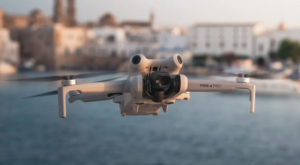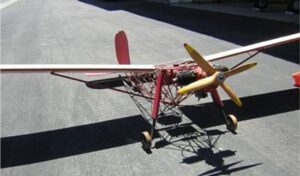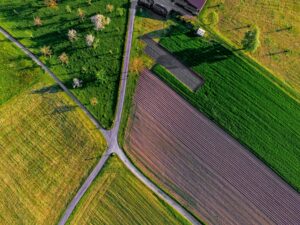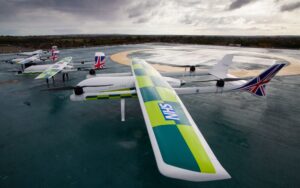
Drones… annoying machines buzzing over your head or invading your privacy. When used commercially they are transformed into revolutionary technological advancements and are being implemented in many different industries to improve safety and speed in a wide variety of operations. We plan to run through some of these today and see if you are as excited as we are…
 A drone flying over water
A drone flying over water
Photo credit: https://www.heliguy.com/blogs/posts/review-10-best-features-of-dji-mini-4-pro
But First a Brief History:
Drones were developed during the First World War – they were classed as UAVs (Unmanned Aerial Vehicles) only they were much bigger, the size of a small plane, than the drones we know today.
Drones were controlled with radios but sadly they were not used in the actual conflict due to the time it took to evaluate and fully develop them, and by then, the war was over. During the Vietnam war, their role changed as they were no longer deployed for running reconnaissance but instead, they became an integral part of the War as they were used to drop missiles and functioned as decoys in combat.
In 1941 Reginald Denny invented the radio plane due to his love of model planes and he approached the military to use them! By 1952 he had produced over 70,000 target drones for the US military!
This is a image of a radio plane from 1952
Photo credit: https://www.wmof.com/rp5a.htm – Western museum of flight
Now military drones are all over the news for their use in various conflicts, however, there is much more to drone use than their inevitable use in wars.
In the aftermath of Hurricane Katrina’s devastation in 2006, drones emerged in a crucial, new role. The Coast Guard used these small unmanned aerial vehicles (UAVs) equipped with thermal technology to locate survivors. This innovative approach allowed them to find people from over 10,000 feet away, leading to faster and more efficient rescues. this marked a turning point for drone technology in disaster management.
From Military Applications to Agriculture, drones have evolved into versatile tools across various industries.
Drones in Agriculture
In the Agricultural industry, Drones operate in farming, helping farmers with crop spraying, and sowing seeds and they fly over the land and check on crop growth. Farmers usually rely on manual scouting to monitor crop health, identify pests or diseases, and manage irrigation. These methods can be time-consuming, labour-intensive, and may not provide a complete overview of their larger fields.
Drones equipped with multispectral cameras can efficiently capture vast areas of the farm while providing detailed data on crop health, irrigation needs, and potential problem areas this saves the farmer money and improves farm efficiency.
An aerial view of a farm Photo Credit: ricardo-gomez-angel-TbwnUGV4kok-unsplash
An aerial view of a farm Photo Credit: ricardo-gomez-angel-TbwnUGV4kok-unsplash
Drones in Construction
In the Construction industry, traditional methods for surveying land, monitoring progress, and inspecting structures often involve manually checking measurements, and conducting visual inspections from the ground. These methods can be time-consuming, expensive, and potentially dangerous, especially when working on high-rise buildings or hazardous areas.
By incorporating drones into their workflows, construction companies experience significant improvements in efficiency, safety, and cost-effectiveness. Drones are used to inspect roofs, and other structures for damage or defects, reducing the need for scaffolding or risky manoeuvres by workers. Drones can also be used to track and monitor stockpiles of construction materials on-site, ensuring efficient inventory control.
Drones in Real Estate
Drones are being used in the Real Estate industry in the most obvious way, to get beautiful aerial shots of the properties for sale especially if the house sits on a large amount of land. Using the drone gets angles of the house that would make the house even more desirable. As well as creating walk / fly-through videos.
Drones in the Entertainment Industry
Drones are being used in TV and Film too! They are mostly used to capture incredible views, angles, and landscapes much more efficiently than a full-sized helicopter. Drones can hold heavy cameras and now as cameras get lighter with increasing resolution their role can increase further.
Did you know that:
- Skyfall (2012): The famous opening sequence with Bond chasing a villain across rooftops was filmed heavily with drones.
- The Greatest Showman (2017): This movie featured the first-ever “drone catch” in a major film, where a character catches a drone in mid-air.
- The Wolf of Wall Street (2013): A drone shot was used for a party scene.
- Fast & Furious 7 (2015): Drones captured the high-speed car chases.
Drones in Deliveries
Drones can cut down the wait times and carbon footprint, which can be useful for companies like Amazon but also transporting urgent medical supplies!
This is an Image of a group of small airplanes/drones together on a helipad the closest to the camera has green and yellow wings with NHS logo Photo credit: Image Credit: Apian
Drones in Construction
Drones can operate in dangerous environments without risk to human life making them ideal for surveys in confined spaces and for monitoring dangerous activities.
Drones have surpassed our initial perception and through time become powerful tools across many industries. From Agriculture and Construction to Filmmaking and Disaster management, drones are revolutionizing workflows, enhancing efficiency, and creating new opportunities. As battery life, flight range, and payload capacity continue to improve, the future of drone technology holds even more exciting possibilities.
Whether you’re a farmer seeking to optimise crop management or a business owner exploring innovative inspection methods, drones offer a wealth of potential!
We hope you enjoyed reading about drones and how there is so much more to them than being mere toys.
Article by Gemma Ellithorn
Electric Leak Detection | Leak Detection Systems – Sensor (UK)


